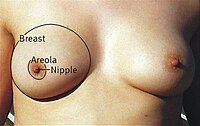
Photo from wikipedia
Dear Editor, It was with great interest that we read the article by Wang et al. [1] concerning the cyclic changes in breast volume over the course of a menstrual… Click to show full abstract
Dear Editor, It was with great interest that we read the article by Wang et al. [1] concerning the cyclic changes in breast volume over the course of a menstrual cycle with 3D imaging scans. The study is important because knowledge of the cyclic changes in breast volume may allow us to filter out this effect when breast volume is registered for other purposes. Accurate measurements of changes in breast volume are especially important for assessing volume retention after fat grafting in the breast which can be used for a breast augmentation or a breast reconstruction [2, 3]. Wang et al. found a significant volume difference between the preand postovulatory phase. The results are in line with previous studies that have used MRI instead of 3D imaging to measure the cyclic changes in breast volume over a menstrual cycle [4, 5]. Although the study by Wang et al. was very well performed, we have a few remarks regarding the article. Wang et al. state that they chose 3D imaging scans because the breast is scanned in an upright position which is similar to the way plastic surgeons inspect breasts, since the prone position used during MRI will result in measurement errors. They consolidate this statement with reference to a study by Kovacs et al. [6]. While we agree that the study by Kovacs et al. shows some advantages with 3D imaging scans such as using the upright position, we disagree with the statement that measurement errors are caused by the prone position. On the contrary, Kovacs et al. concluded that MRI gives more precise volume measurements compared to 3D imaging scans. Also, MRI can distinguish the breast tissue from the chest wall. However, the shape of the breast on a constructed 3D model will appear anatomical inaccurate due to the prone position. This is in line with previous studies [7, 8]. Wang et al. present the cyclic volume changes as absolute volumes. It is likely that the changes depend on the breast volume as well as the amount of glandular tissue since it may be more susceptible to the hormonal changes than the adipose tissue of the breast. It would be very helpful if the authors could provide the volume changes as a percentage of the total breast volume. Lastly, we thank Wang et al. for presenting their findings consistent with earlier results on this fundamental and important topic. It could become a crucial and valuable tool in cosmetic as well as reconstructive plastic surgery.
Journal Title: Aesthetic Plastic Surgery
Year Published: 2018
Link to full text (if available)
Share on Social Media: Sign Up to like & get
recommendations!